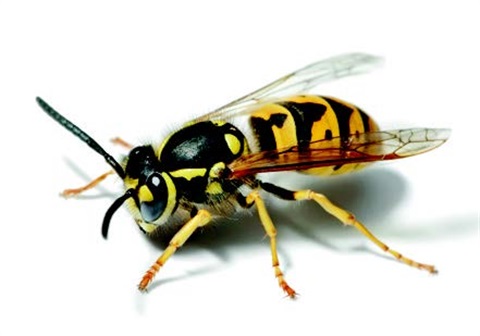European Wasps

The first European Wasps were discovered in South Australia in 1978. European wasps are attracted to sweet foods and meat and are commonly a nuisance at outdoor eating events and barbeques. The European wasp is identifiable by: its black and yellow body; its yellow legs and triangular markings on the abdomen. Do not aggravate a European wasp if detected on your property!
European Wasps are not pleasant creatures to have in and around your home. If you sight European Wasps this indicates that there is a nest or two close by. It is important that you locate the nest and have it destroyed. The most effective means to control a European wasp problem is to destroy their nest.
To make sure there are no nests on your property, you need to check and look for signs of numerous wasps flying in and out of one particular area to indicate a nest site.
Signs to look for
Normally you will not see the actual nest so look for the following signs in the first instance:
- A hole in the ground or retaining wall (nest inside cavity in the ground or wall).
- Vents in the outside of your house (nest will be in the wall).
- Hollows of trees (nest inside hollow tree trunk).
- Eaves of houses (nest inside roof cavity).
European wasps have very direct flight patterns between their nests and food sources. They can fly up to 500 metres from the nest in search of food and go directly back to the nest once food has been obtained. When looking for the nest you will only see an entrance hole with wasps flying in and out.
What to do if you find a nest
Should you find a nest please contact Adelaide Pest Control on 1300 783 875.
- Adelaide Pest Control will treat nests at properties, please call the hotline 1300 783 875 for advice.
- If Adelaide Pest Control attend the property and determine anything out of the ordinary needs to occur e.g. elevated platforms, roof tile removal to access the roof, etc., you may need to pay for the extra costs.
- If a property has numerous different nests over different times, they will attend and treat each nest, but Council are charged for each different call out.
- Most of the time there is no need for a second treatment as a 7 day guarantee will be given. However, if the wasps are still around after 48 hours, please call the hotline and they will complete a second treatment at no charge to Council as long as its within the 7 days.
- The resident must know the location of the wasp nest before calling.
- If the wasps are found to be native wasps, the resident will be charged a call out fee or a fee to remove the nest if they choose to go ahead.
Wasps as Pests
European wasps prefer to nest around human habitation where they can scavenge food and sweet liquids. Large numbers of wasps can be attracted to picnics and barbeques and interfere with outdoor activities.
To discourage wasps from your property:
- Do not leave fallen fruit or food scraps lying around your yard.
- Avoid leaving uneaten pet food or dog bones outside.
- Make sure rubbish bins have tight fitting lids.
- Keep compost covered at all times.
- Keep your swimming pool covered when not in use.
- Cover exposed food at picnics and barbeques.
- Don't drink out of cans or bottles, use clear containers or a straw.
Wasps can sometimes be beneficial in gardens by removing caterpillars and other such garden pests. However, they make pests of themselves by damaging ripening fruit. To help reduce the numbers of European wasps in your backyard, the home gardener must continually clear all fruit that has fallen to the ground.
Information sourced from Museum Victoria website.
What if you are stung?
Unlike a bee, wasps can sting repeatedly. Apply an ice-cold pack to a sting to relieve the fiery pain and red swelling. Take oral analgesics if SEVERE pain occurs.
Multiple stings to the face or neck can lead to severe swelling and/or allergic reaction. If this occurs and the person has difficulty breathing contact an ambulance, hospital or doctor.
For information on FIRST AID and wasp stings, see healthdirect.gov.au